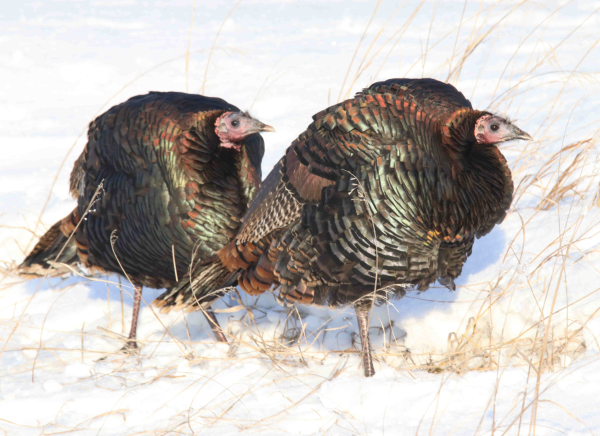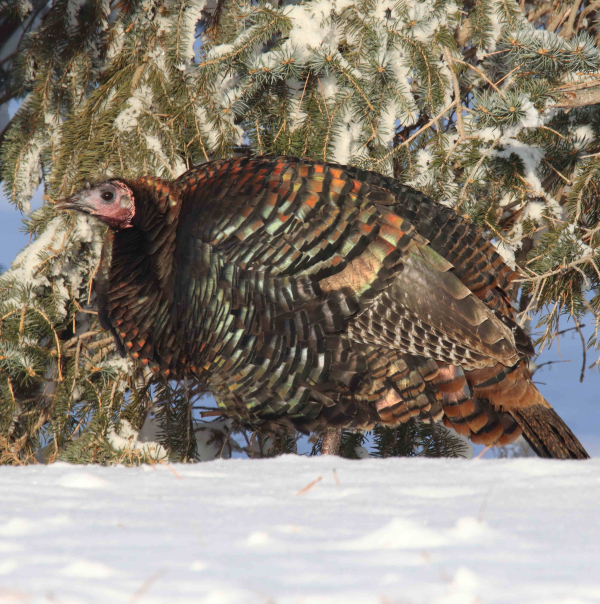
The intense cold of the January afternoon provided a different look at Wild Turkeys that minimized the amount of bare skin and maximized the expanse of their plumage to contain air warmed by their body. Although the sun had little heating value, it provided ample light to highlight the iridescent colors of the turkeys’ plumage.

A second turkey feeding area was beneath snow-covered spruce boughs, highlighted by Wednesday’s setting sun.

Regal Ring-necked Pheasants have been the most commonly encountered birds during a week of minimal sightings.
|
It’s been some time since I traversed the Missouri Coteau eastbound, then ambled north along the east side of the Missouri River Valley to Bismarck. Along the way last Wednesday, a flock of 15 Snow Buntings broke the uniformity of Ring-necked Pheasant sightings, numbering 7, 3, 3, 2, and 1 before I found a pheasant hotspot of at least 60 feeding in a harvested cornfield adjacent to several acres of wooded habitat. Then, southeast of the capitol city, near the location where I observed the family group of Whooping Cranes last fall, I encountered 4 very cold Wild Turkeys that were showing a minimum of bare skin on their head with extra-expanded plumage to create the thickest possible layer of insulated warm air between their outer feathers and their heat-generating body.
The timing was perfect for photography with the sun low in the southwest, so I gently pulled off the road at a convenient approach and waited for the turkeys to move into the open as they continued to forage through the snow under tall grasses. The brilliant iridescent colors of the turkeys were on full display as they turned into the sun, and they soon provided some nice photo ops. Eventually, one of the turkeys walked to a stand of spruce trees laden with snow, which provided another setting to photograph it, and the rest of the foursome eventually headed in that direction and disappeared behind the pines. I did see 2 more Wild Turkeys south of Bismarck too, but that still left my afternoon birding total at a mere 3 species.
Closer to home, Friday’s sunshine provided an impetus to check out the southland up to 20 miles south, which revealed 3 Sharp-tailed Grouse before I turned east to check out an area of wildlife plantings where I observed a wealth of pheasants on my way to Minneapolis the week before. There were plenty of Ring-necked Pheasants, but a large figure in the lone giant cottonwood tree dominated my attention – an adult Bald Eagle!
As I studied the eagle, movement to my right caught my attention as my car was being surrounded by pheasants in flight from their cornfield feeding area to the thick cover of the wildlife cover. More than 30 pheasants glided by in an impressive wave of flight before spreading their wings and tail to break their momentum as they landed behind the bushes and trees covered with a dense blanket of snow – quite a sight. A few miles to the north, a duo of hen pheasants topped off my bird list for the day.
Saturday’s sunshine made me want to venture westward a dozen miles across the broad valley where the Rough-legged Hawks assembled a couple months ago – Hawk Valley. But the broad basin was void of birds, as was my route to and from the area, including a side trip a few miles to the north at one point. I hate to report, or admit, that I spent an hour in the field without seeing a bird, but for the record: My tally was a goose egg.
Sunday I was concerned that any birding would be a lost cause, but I fought through those feelings and hit the road to the south, intent on checking on the pheasants at the wildlife area and other birds along the way. A lone Sharp-tailed Grouse punctuated the top of a frosty bullberry bush on a vast open prairie area and ensured I wouldn’t be skunked during that drive. Even so, birds were absent from my view until I spotted the Bald Eagle, still present in the lone cottonwood. I was surprised the big raptor was still in position, but it had an ample food source. Yet, there were no pheasants to be seen during my short stop. How was that possible after seeing so many Ring-necks a few days earlier?
Well, the eagle’s presence may have induced some pheasants relocate, but a more likely answer might be that the pheasants were out of view behind the ample cover of trees, bushes, grasses, and snow. However, another potential food source for the eagle was now evident in the form of road kills. With a sizable aggregation of White-tailed Deer numbering more than 80 spread out through the adjacent cornfield, nighttime traffic had created 5 deer carcasses that coyotes utilized at night and the Bald Eagle probably fed on sometime during the day – maybe, probably – or the eagle may be taking a pheasant periodically too.
Anyway, it was nice to see the eagle during this nearly birdless period, which is unlike any time I’ve experienced in the area before – a testament to the depth of the snow, and probably the deep winter cold. On the way home, at the same location where I saw the 2 female pheasants Friday, there were 3 colorful males Sunday. Although I observed a flock of Snow Buntings an hour west of my office on the way to Bismarck a week ago, I haven’t seen Snow Buntings in my home range – likely another species that’s evacuated this ultra-Arctic realm. But wait, Snow Buntings are Arctic species! At least they nest in the Arctic.
I’m guessing the high snow levels necessitate the birds moving south – far south probably, considering that South Dakota birders observed few Snow Buntings during Christmas Bird Counts, mostly conducted after the big pre-Christmas storms. Nebraska birders are reporting some Snow Buntings along with “plenty of flocks of Lapland Longspurs,” another Arctic nester that usually winters here with Snow Buntings, but left this area long ago. The moral of the story is probably for me to migrate south pronto, and I’m working on that; not because of the snow and cold, because of the lack of birds. How’s that for a sign of a true red-blooded birder? Ha-ha. Enjoy the birds around you, and I promise to share some stories of winter hotspots for birders next week!
Article and photos by Paul Konrad
Share your bird sightings and photographs at editorstbw2@gmail.com